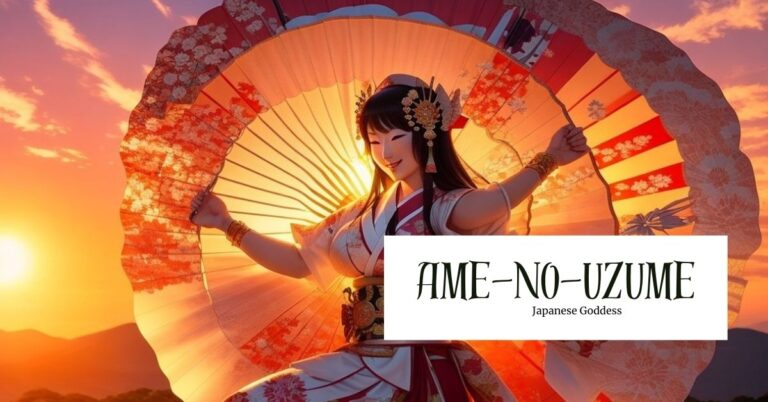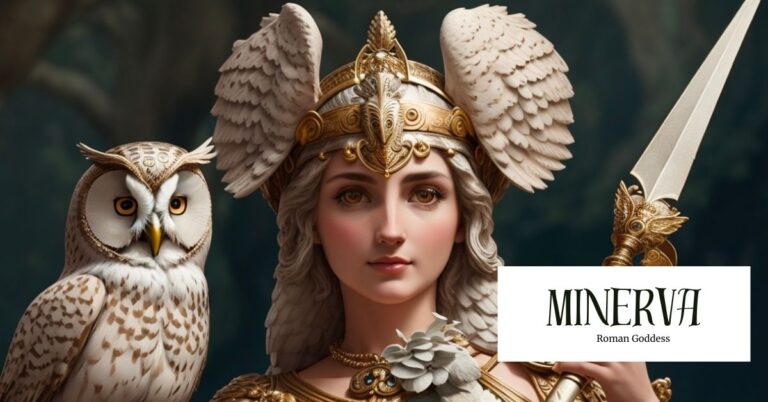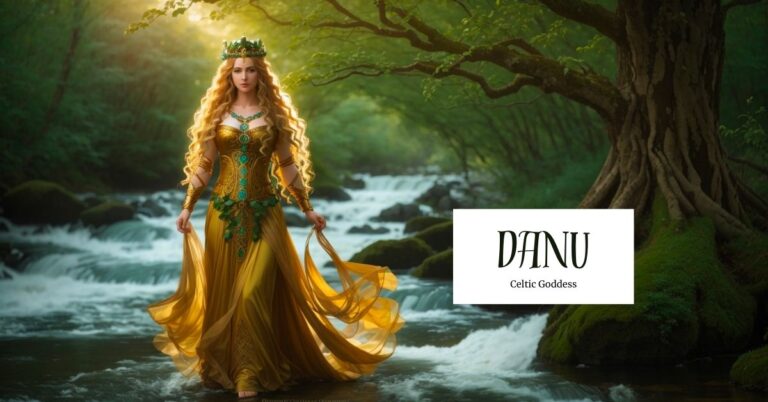Freya: Goddess of Love, Beauty, and Magic
The Norse mythological tradition is replete with rich and complex figures, and among them, Freyja or Freya. Hailing from the realm of the Aesir, Freya plays a critical role as the goddess of love, beauty, and magic, with her influence extending across a range of titles, defining characteristics, and potent symbols. A closer examination of her mythological narrative reveals a figure whose impact transcends the confines of ancient Norse culture, leaving an indelible mark on both the divine and mortal realms.
Overview of Freya
Freya, also known as Freyja, holds a prominent position within Norse mythology as a member of the Aesir tribe, a group of deities residing in Asgard, the celestial realm of gods. Freyja, derived from the proto-germanic feminine noun frawjōn, translates to ‘lady,’ ‘woman,’ or ‘mistress,’ thus underscoring her significance among the Norse deities (Lockett).
Freya embodies a multifaceted character, representing the essence of love, fertility, beauty, and magic, making her a captivating and enigmatic figure deeply intertwined with the hearts and beliefs of the Norse populace. Her radiance and potency have made her a powerful symbol in Norse mythology, revered for her many attributes and influence over the natural world.
Source: Adobe Stock
Titles
- Queen of the Valkyries
- Lady of the Vanir
- Goddess of Love
- The Seeress
Abilities
Freyja is known for her exceptional range of abilities and remarkable influence. Her mastery of Seidr, a complex form of Norse magic associated with divination and fate manipulation (Lockett), has earned her recognition as the foremost practitioner of this skill. With her mastery of Seidr, Freyja can perceive the intricate threads of destiny and shape them to her advantage (Groeneveld).
In addition to her mastery of Seidr, Freyja possesses a falcon-feathered cloak that endows her with the power to transcend the mortal realm and travel effortlessly between different domains. This garment enables her to cover vast distances in the blink of an eye (Apel). This skill signifies her dominion over various dimensions and solidifies her status as a goddess of unparalleled power. Freyja’s connection to the cycles of life and creation is further deepened by her divine tears, which possess an extraordinary capability. When these tears fall, they transform into precious amber, a tangible manifestation of her profound link to the very essence of life (Dowdeswell). This symbolic transformation underscores her role in the circle of existence, where birth, growth, and eventual change are integral.
Characteristics
Freyja is an embodiment of beauty, radiance, and sensuality, captivating the hearts and imaginations of mortals and gods alike (“Freyja – New World Encyclopedia”). Her portrayal is of ethereal elegance, often depicted with golden tresses cascading like sunbeams, as a tangible representation of her divine luminance (Dowdeswell). This radiant mane symbolizes her status as a goddess who holds sway over matters of allure and fertility, further affirming her role as a beacon of vitality within the pantheon (Groeneveld).
Freyja’s eyes, often described as holding the mysteries of the cosmos, mirror the complexities of existence—capturing its splendors and its trials and tribulations (Apel). This celestial gaze speaks to her profound insight and understanding, suggesting a deity attuned to the intricacies of mortal lives and the divine order. Her attire, adorned with precious jewels and fabrics that shimmer like starlight, is a regal testament to her status (Lockett). The splendor of her garments accentuates her allure and signifies her elevated position among the gods.
Source: Adobe Stock
Traits
At the heart of her character are fierce independence and unwavering determination, which empower her to navigate the intricate web of both divine and mortal realms (Lockett). Freyja’s spirit burns passionately in matters of love and as a formidable warrior goddess (Dowdeswell). Her battlefield prowess and courage in the face of conflict testify to her dual nature—a harmonious blend of ethereal beauty and indomitable strength (Groeneveld).
Her compassionate heart is central to her character, a trait that extends beyond her divine form to touch the lives of her devotees and loved ones (Wikipedia Contributors). Her willingness to offer aid and protection underscores her role as a goddess of love and familial bonds, forging connections that transcend the boundaries between mortals and deities (Apel). This capacity for empathy enhances her allure, endearing her as a deity of power and a beacon of benevolence. Freyja’s traits form a mosaic of contradictions and harmonies, weaving a narrative that encompasses her internal conflicts and her capacity for empathy and strength. Her character reflects the intricate dance between vulnerability and grit, mirroring the complexities of the human experience while embodying the divine spirit that sets her apart in Norse mythology.
Symbols
The essence and dominion of Freyja encapsulate various evocative symbols that speak to her multifaceted role (Groeneveld). Among these symbols, the Brísingamen stands out as the most iconic (Lockett). Skilled dwarves crafted this enchanting necklace as a testament to her exalted position and a potent representation of her association with love and beauty. Through its exquisite embodiment of her allure and fertility, the Brísingamen captures the very essence of her divine nature (Apel).
Another symbol that represents Freyja’s essence is her chariot, drawn by two majestic felines (Dowdeswell). These creatures mirror her independent and enigmatic nature and add an air of mystery to her character. Additionally, her affinity for cats enhances her connection to the animal realm, further establishing her dominion over the natural world. These symbols vividly depict Freyja’s essence, weaving together the beauty and power that define her enduring presence within Norse mythology.
Source: Germanic Mythology
Festivals and Rituals
The influence of Freyja extends beyond her divine attributes and is expressed through various rituals and festivities. One such celebration is the “Freyfaxi” festival, which takes place during the harvest season and pays tribute to Freyja’s significant role as a fertility goddess. During this festival, devotees express gratitude and make offerings to secure bountiful crops and prosperity (Lockett), honoring Freyja’s power as a source of abundance and her connection to the cycles of life and nature. The “Freyfaxi” festival is a vibrant commemoration that underscores the profound significance of Freyja within Norse culture.
Source: Nordic Culture
In addition, the name “Friday” is related to Freya, or possibly Frigg. Regardless, Fridays are sacred days to Freya. In addition, she is associated with the number 13 because there are 13 moons in the year and, correspondingly, the expected amount of menstrual cycles. Thus, Friday the 13th is especially sacred to Freya.
Legends associated with Freya
Among the divine beings of Norse mythology, Freya stands out as a figure of intrigue, embodying the delicate balance between power and love. The legends associated with Freya are as diverse as they are enchanting, weaving together intricate narratives that bring to light the multifaceted aspects of this deity’s character. From her associations with fertility and sexuality to her role as a mighty warrior and leader, Freya’s tales offer a glimpse into a world of myth and imagination that continues to captivate and inspire us today.
Origin story
At the core of Freya’s mythology lies an origin narrative that serves as the foundation of her divine presence. Freya is recognized as the daughter of Njord, the sea god, and the twin sister of Freyr, the deity associated with fertility and prosperity. This lineage shows her intrinsic connection with the natural world, with her father’s reign over the vast oceans and her brother’s role in the cycle of life.
However, the origin tale of Freya comprises intriguing variations, each of which amplifies her significance within distinct contexts. In the pages of the “Gylfaginning” segment of the Prose Edda, a valuable compilation of Norse myths, Freya emerges as a revered member of the Vanir, the tribe of deities acknowledged for their association with fertility and prosperity. This tale unfolds with Freya being dispatched to dwell among the Aesir, the primary pantheon of Norse gods, as a symbol of peace after the tumultuous Aesir-Vanir war (Wikipedia Contributors). This transition highlights her pivotal role as a mediator, bridging the divide between warring factions and signifying her profound influence in forging harmony among the divine entities.
Source: Norse Mythology for Smart People
The Acquisition of the Brísingamen
According to the captivating legends within Freya’s mythology, the acquisition of the Brísingamen, a legendary necklace of extraordinary beauty and significance, has remained a tale of great intrigue. It is said that Freya’s desire for the Brísingamen led her to the domain of skilled dwarves, who held the power to forge such a masterpiece. These dwarves, recognizing the allure and importance of the necklace, offered it to Freya in exchange for a price that reflected her captivating nature – a night spent with each of them.
Despite the societal norms and expectations that would have deterred most, Freya remained undeterred and guided by her agency. She agreed to their terms, revealing her unapologetic embrace of her desires and independence. This narrative serves as a testament to the enduring power of Freya’s mythos and the value she placed on her autonomy and the pursuit of her desires, even in the face of societal expectations and norms (Apel).
Source: Silver and Gold
Freya and Odin: A Mythical Tale of Wisdom and Magic
An enthralling legend within Norse mythology depicts the intriguing connection between Freya, a revered deity associated with beauty and love, and Odin, the chief god of the Norse pantheon.
Freya teaches Odin the intricate art of Seidr, a form of Norse magic that involves divination and manipulating fate (Groeneveld). Thus, in this narrative, Freya assumes the role of a teacher, imparting her profound wisdom to Odin himself. The tale highlights Freya’s exceptional mastery of mystical arts and her deep insight into the threads of destiny.
This knowledge exchange underscores Freya’s pivotal role as a powerful seeress whose gaze reaches beyond the ordinary realms, perceiving the intricate tapestry of existence. It further elevates her position as a deity who commands not only beauty and love but also the profound mysteries of the cosmos. Her ability to bestow wisdom upon even the highest of gods reinforces her status as a figure of extraordinary influence and power within the Norse pantheon. As the bearer of divine secrets and the keeper of arcane arts, Freya’s connection with Odin solidifies her legacy as a goddess of unparalleled insight and mystique.
Source: Reddit
Influences of other religions/cultures on Freya
Because Norse religion emerges from Germanic tribes, a fascinating perspective emerges when considering the potential connection between Freya and Frigg, the Germanic mother goddess and Odin’s wife (Dowdeswell). This suggestion highlights the fluid nature of mythological attributes and the intricate intermingling of beliefs as cultures evolved and interacted. It is suggested that the Norse began separating the goddess into Freya and Frigg, but originally they were one.
The resemblance between Freya and Frigg raises questions about the shared narratives and attributes these goddesses may embody. While Freya’s dominion lies in love, beauty, and fertility, Frigg is often associated with household, family, and domesticity matters. The notion that these two distinct deities might share commonalities underscores how myths and cultural nuances can transcend boundaries. The convergence of Freya and Frigg echoes the intertwining threads of different belief systems, illustrating how mythologies evolve and adapt in response to diverse cultural contexts. This dynamic relationship between deities, shaped by the ever-shifting landscapes of human imagination and interaction, serves as a poignant reminder of the fluidity and complexity of religious beliefs and their timeless impact on the human experience.
When the Vikings converted to Christianity, many women clung to the worship of Freya. However, given her associations with love and lust, the church could not convert Freya into a saint as they did with so many gods and goddesses. Instead, the church demonized Freya. Her special day, Friday the 13th, was turned into a day of ill omens and bad lack.
Modern appearances
The timeless allure of Freya has endured into the present era, gracefully transcending the limitations of ancient texts and resonating deeply within various aspects of contemporary culture, literature, and spiritual practices. The prominence of Freya within popular consciousness experienced a revival during the emergence of Germanic nationalism in the nineteenth century. Notably, Freya was referenced in the Danish national anthem penned by Adam Oehlenschläger, titled “Der er et indigo land” (“There is a Lovely Land”), wherein “old Denmark” was described as “Freya’s hall.” (Apel). In recent times, Freya also appeared in the popular video game God of War as The Witch in the Woods.
Source: Villains Wiki
Final thoughts
The Norse goddess Freya, known for her embodiment of love and power, is a figure of great complexity and allure in mythology. Her origin story, rich with captivating nuances, unfolds alongside her dynamic interactions with fellow deities, painting a vivid portrait of her influential presence. Across diverse cultures and epochs, the enduring impact of Freya remains a testament to the eternal interplay between beauty, strength, and love. These tales, resonant with profound insights, serve as a continuous source of inspiration, reminding us of the enduring potency of mythology in its capacity to reflect and shape the essence of the human experience.
References
Apel, Thomas . “Freya.” Mythopedia, 18 Nov. 2021, mythopedia.com/topics/freya.
Dowdeswell, Molly. “The Story, Symbols and Powers of Freya, the Norse Goddess of Love.” Www.ancient-Origins.net, www.ancient-origins.net/myths-legends-europe/freya-norse-goddess-0017280.
“Freyja – New World Encyclopedia.” Www.newworldencyclopedia.org, www.newworldencyclopedia.org/entry/Freyja.
Groeneveld, Emma. “Freyja.” World History Encyclopedia, 19 Feb. 2018, www.worldhistory.org/Freyja/.
Lockett, Rachel. “Freyja: The Norse Goddess of Love, Sex, War, and Magic | History Cooperative.” History Cooperative , 4 Jan. 2023, historycooperative.org/freyja-the-norse-goddess-of-love/#:~:text=The%20name%20Freyja%20in%20Old. Accessed 11 Aug. 2023.
Wikipedia Contributors. “Freyja.” Wikipedia, Wikimedia Foundation, 6 Nov. 2019, en.wikipedia.org/wiki/Freyja.







